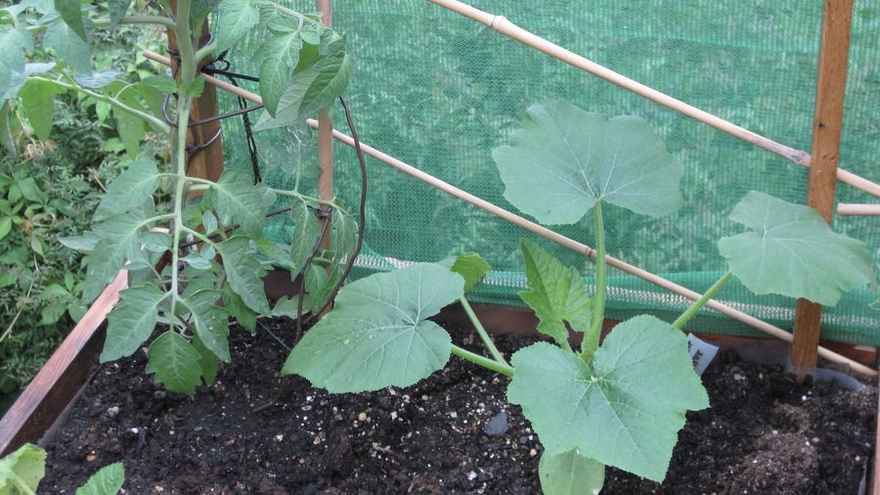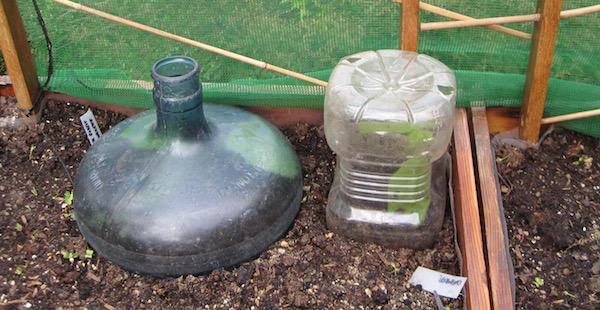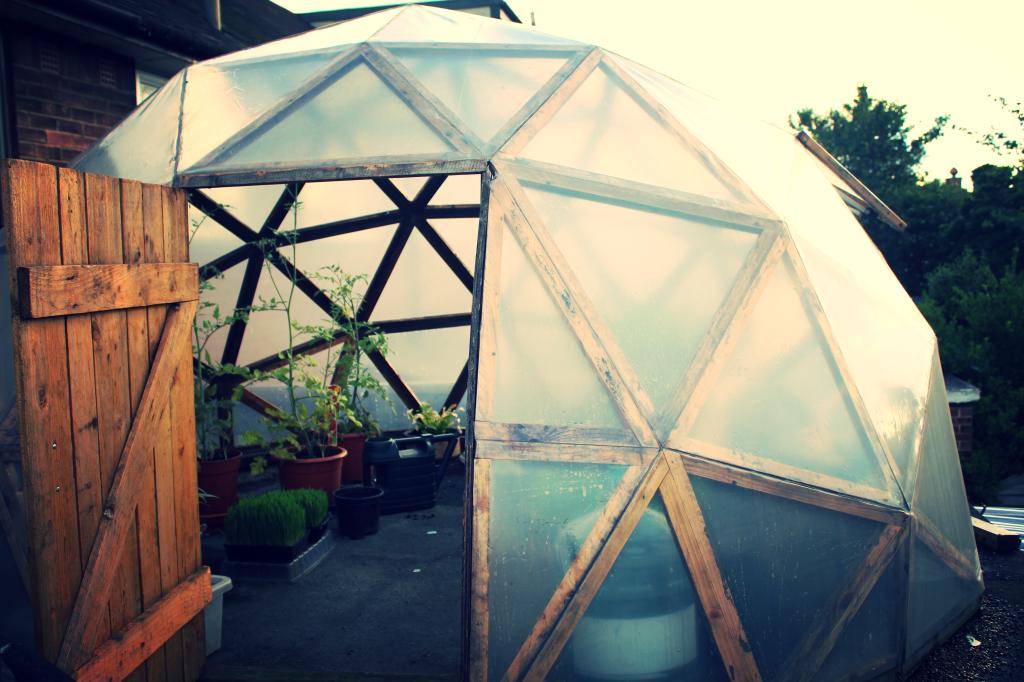Wind: why it's a problem and how to reduce it's impact

Strong winds can be a headache if you're trying to grow food in the city. Balconies and roof tops are often exposed. Wind gets funnelled between buildings.
Some air movement is good for plants (it helps reduce disease), but persistent or strong winds are not. It can be difficult to grow successfully in very windy places - and, if you are starting out, the wind can be so disheartening it may even put you off growing altogether.
Don't lose heart yet. The good news is that it's often possible to reduce the wind or minimise its impact - and transform an inhospitable growing space into a productive food garden.
Why plants don’t like wind…
In persistent wind, plants close their leaf pores (called ‘stomata’) to reduce water loss. Closing these pores also limits the plants ability to breath, slowing growth (and your harvests) by 50% or more. Wind will also make containers dry out faster, adding more stress to your plants.
In strong winds, plants can be physically damaged. Stems snap, leaves and flowers are ripped off. This is traumatising for the plants - and for you if you are watching it! (I once felt moved to drag huge tomato plants into the living during a storm).
Is there a solution?
Some spaces are easier to reduce wind in than others. But even if you can't reduce the wind, you can do something to reduce its affect. Broadly there are three tactics to explore - and that you can read more about below:
- Use a wind break or shelter - this is often very effective where it's possible.
- Tie up your plants well and adjust watering routines to reduce the impact of the wind.
- Choose plants that are better adapted to the wind.
Learn about the wind in your space
The first thing, though, is for you to observe where the wind in your growing space comes from. If it's usually from the same direction, you might be able to get away with a windbreak on just one side.
In many cities, the wind direction and strength will also vary with the seasons. So you'll want to find out how it changes month by month. A search engine can help you find the ‘prevailing winds’ for your area. In much of the UK, for example, North Easterly winds (cold, dry and persistent - particularly bad for growing) are common in the winter and spring; South Westerly winds (warmer and often stronger) in the summer. Just remember that buildings can funnel and bounce winds - so the ‘official’ wind direction may be different to what you actually experience!
If the wind is worst at certain times of year, your problem might be a temporary one. On my North West facing balcony in London, for example, North Easterly winds early in April / May made it hard to start plants off. I got round this by putting out some plants later (they usually caught up), putting up temporary windbreaks, and using home made covers (like empty water cooler bottles - see picture below) to protect the plants that really hate cold winds - like courgettes and tomatoes. Once June came, the wind was less of a problem - the North Easterlies were largely finished and the space was more sheltered from the South Westerly winds.
Every space is different and unique - so it is a case of observing and learning about yours (this can take time - you can still be learning about even a small space after several years!).
 Scaffold netting windbreak and water cooler bottle shelters or 'cloches'. I used these on my balcony to protect plants from persistent North Easterly winds in the spring.
Scaffold netting windbreak and water cooler bottle shelters or 'cloches'. I used these on my balcony to protect plants from persistent North Easterly winds in the spring.
1. Windbreaks and Shelters
A windbreak can transform an inhospitable growing space into a productive food garden.
Some spaces are easier to fit windbreaks to than others. If you don’t have an obvious structure to attach one, you may be able create one. For example, on my balcony, I fitted upright posts to the back of large wooden containers - and used these to attach a windbreak (pictured above).
To be effective, a windbreak needs to be partly permeable - ideally about 40 - 50%. Solid windbreaks create turbulence on the ‘sheltered’ side, making them less effective.
Before you fit a windbreak, particularly if you are growing in a shady site, bear in mind that it may further reduce the light getting to your plants. However, in the words of Capital Growth's, Julie Riehl: “I think plants suffer more from high wind than from a slight lack of sun!”
What sort of windbreak?
Netting
 Scaffold netting makes an effective windbreak. This is fixed to posts screwed into the back to wooden containers.
Scaffold netting makes an effective windbreak. This is fixed to posts screwed into the back to wooden containers.
Black or green windbreak material is widely available (from gardening suppliers and on Ebay). Scaffold debris netting (pictured right) can be found in skips near building sites and does the job just as well . I've heard of people using coffee jute bags (ask coffee suppliers), although I haven’t tried these myself.
If you’ve got rails (balcony rails are ideal) or other attachment points (eg hooks in the wall), netting is usually easy to put up. Use cable ties to make a quick and secure attachment, that is easy to remove, too.
Woven wood panels
An attractive alternative to netting, is panels of woven wood. Rush and willow panels can often be purchased from garden suppliers. In the same vein, and easier, Julie Riehl advises: "you can add a small bamboo or brushwood mini wall around your veg"
If you can find a supply of green wooden branches in the city (which might not be as difficult as it initially sounds - ask a tree surgeon or in your local park) you can even weave your own windbreak. This has the benefit that you can make it to the exact size and design you want. Ruth Thompson from Sylvan Skills shows you how in the video below (thank you Ruth!).
https://youtu.be/O7y69WCWzeM
Living windbreaks
Another attractive way to create a windbreak is to use plants.
Julie Riehl says: "I plant low growing, non edible plants (like periwinkle, or small euonymus bushes) that offer a small barrier and then put edible plants in between these .”
If you've got more space, large containers planted with bamboo or willow, can work very well and look great, too.
Shelters, cloches, greenhouses
A cover or “cloche” (eg a plastic water cooler bottle) is handy to shelter smaller plants from the wind, particularly while they get established (it will offer some slug protection). Or you can buy or make a mini-greenhouse. I’ve seen people construct greenhouses or mini polytunnels on rooftops -Wojciech even built a geodesic dome on his balcony (below) - amazing!
 Geodesic dome built by Wojciech on his balcony
Geodesic dome built by Wojciech on his balcony
2. Reducing the impact of wind
To reduce the damaging effect of wind, tie the new growth of tall plants and climbers - like peas and vine tomatoes - to sticks or frames to support them. You really need to do this in any space, but it's even more critical if it's persistently windy or heavy winds are forecast.
Plants use more water on windy days. With limited soil in a pot, it is prone to dry out, further stressing the plant. You can avoid this by watering more frequently in windy times. Or by growing in larger containers (hold more water) or adding water reservoirs to you containers.
3. Choosing what to grow
No plants actually like strong winds (that I know of!). But some are better adapted than others.
Julie Rhiel, from Capital Growth, has experience growing in several windy container gardens in London, including the Grain Store, pictured below.
 The Grain Store is in an exposed and windy square, Kings Cross, London.
The Grain Store is in an exposed and windy square, Kings Cross, London.
Julie shares what she has found grows well in the wind - and what does not:
“From my experience, what works better are:
- Tougher plants with smaller leaves that offer little wind catch area. ‘Needly’ herbs like rosemary, cotton lavender and other lavenders are quite good in the wind, so is thyme. Fennel has done very well on some of our very windy locations, especially the green as opposed to bronze fennel.
- Plants that are lower like dwarf kale and curly parsley did well in windy sites over winter. Radish, carrots and most root veg did well too. Equally violas did better than marigold for example. All delicate chilli and tomatoes did very poorly (even the bush variety), Strawberries- especially wild- do well in windy sites too.
- Anything high and weedy is kind of doomed: leeks, big cabbage, broccoli and Brussel sprouts are out. Rhubarb, sunflowers, potatoes are also not great.
- Some dwarf versions of big vegetables do surprisingly well: Hestia beans, dwarf pop corn maize, any nasturtium that grows in ball as opposed to trailing
- With proper support, you can grow tough trailing veg- we had great sweet peas, peas and runner beans using sturdy bamboo structures to support the plants.
- In my experience, fruit trees grow, but are under too much stress to produce fruit. All the ones I have grown were in windy area And in pots. Maybe if they are in the ground they would fruit. Do let me know if you experiment!
- On the non veg side: Hebe and Ivy AWAYS survive, as well as dwarf bamboo and box trees. Alyssum are also great (and smell heavenly), and house leaks are virtually indestructible.
Every garden is different almost every year. All species will be slightly dwarfed, but most will grow a bit. I think it’s about trying a few different species in your garden and recording what works well. Avoiding lots of one species will limit the damage if it does not do well. They need extra love to make it work- lots of water and potentially some good organic feed to help them grow despite the weather.
The good news is that pigeons hate the wind, and have left my windy sites intact so far."
A big thank you to Julie for sharing her years of invaluable experience.
 Low growing plants like parsley and viola are good choices in windy places.
Low growing plants like parsley and viola are good choices in windy places.
Your turn
If you grow in a windy space, I’d love to hear about your experience in the comments below. Have you found any way to reduce the wind? Or have you found any plants that grow well... or not so well?

9 comments
Leave a comment